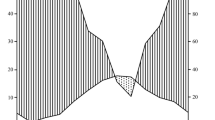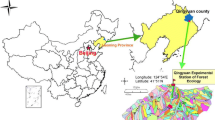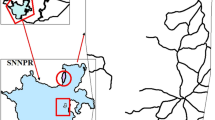Abstract
Aiming to support the use of native species from the Atlantic Rainforest in local agroforestry systems, we analysed chemical and biochemical components related to leaf decomposition of Inga subnuda, Senna macranthera, Erythrina verna, Luehea grandiflora, Zeyheria tuberculosa, Aegiphila sellowiana, and Persea americana. These tree species are native (except for P. americana) and commonly used in agroforestry systems in the Atlantic Rainforest. For the three first species (Fabaceae), we also analysed the remaining dry matter and released nutrients from leaves, using litter bags, and biological nitrogen fixation, using Bidens pilosa and Brachiaria plantaginea as references of non-N2-fixing plants. Leaves from I. subnuda, L. grandiflora, and P. americana had a lower decomposition rate than the other species, exhibiting negative correlations with lignin/N and (lignin+polyphenol)/N ratios. The percentages of remaining dry matter after 1 year were 69 % (I. subnuda), 26 % (S. macranthera) and 16 % (E. verna). Higher nutrient release was found in decreasing order from residues of E. verna, S. macranthera, and I. subnuda. The percentages of nitrogen fixation were 22.6 % (E. verna), 20.6 % (I. subnuda) and 16.6 % (S. macranthera). Diversification of tree species in agroforestry systems allows for input of diversified organic material and can contribute to maintaining and improving soil functions resulting in improvements of soil quality.



Similar content being viewed by others
References
Anderson JD, Ingram JSI (1993) Tropical soil biology and fertility: a handbook of methods, 2nd edn. Wallingford, UK 221p
Barberi A, Carneiro MAC, Moreira FMS, Siqueira JO (1998) Nodulação em leguminosas florestais em viveiros no Sul de Minas Gerais. Cerne 4:145–153
Beddy TL, Snapp SS, Akinnifesia FK, Sileshi GW (2010) Impact of Gliricidia sepium intercropping on soil organic matter fractions in a maize-based cropping system. Agric Ecosyst Environ 138:139–146
Braga JM, Defelipo BV (1974) Determinação espectrofotométrica de fósforo em extratos de solos e plantas. Rev Ceres 1:73–85
Bruneau A, Mercure M, Lewis GP, Herendeen PS (2008) Phylogenetic patterns and diversification in the caesalpinioid legumes. Botany 86:697–718
Bryan JA, Berlyn GP, Gordon JC (1996) Toward a new concept of the evolution of symbiotic nitrogen fixation in the Leguminosae. Plant Soil 186:151–159
Cardoso IM, Guijt I, Franco FS, Carvalho AF, Ferreira-Neto PS (2001) Continual learning for agroforestry system design: University, NGO and farmer partnership in Minas Gerais. Agric Syst 69:235–257
Costanza R, D’Arge R, De Groot R, Farber S, Grasso M, Hannon B, Limburg K, Naeem S, O’Neill RV, Paruelo J, Raskin RG, Sutton P, van den Belt M (1997) The value of the world’s ecosystem services and natural capital. Nature 387:253–260
Curl EA, Rodriguez-Kabana R (1972) Microbial interactions. In: Wilkinson RE (ed) Research methods in weed science. Atlanta, Southern Weed Society, pp 162–194
De Faria SM, Franco AA, Jesus RM, Menandro MS, Baitelli JB, Mucci ESF, Dobereiner J, Sprent JI (1984) New nodulating legume trees from South-East Brazil. New Phytol 98:317–328
De Faria SM, Diedhiou AG, de Lima HC, Ribeiro RD, Galiana A, Castilho AF, Henriques JC (2010) Evaluating the nodulation status of leguminous species from the Amazonian forest of Brazil. J Exp Bot 61:3119–3127
Duarte EMG (2007) Ciclagem de nutrientes por árvores em sistemas agroflorestais na Mata Atlântica. MSc Thesis, Federal University of Viçosa, Viçosa
Embrapa (1999) Manual de análises químicas de solos, plantas e fertilizantes. Brasília: Embrapa Solos/Embrapa Informática Agropecuária/Embrapa. p 370
Gehring C, Vlek PLG (2004) Limitations of the N-15 natural abundance method for estimating biological nitrogen fixation in Amazonian forest legumes. Basic Appl Ecol 5:567–580
Giller KE (2001) Nitrogen fixation in tropical cropping systems, 2nd edn. CAB International, Wallingford
Goering HK, van Soest PJ (1970) Forage fiber analyses (Apparatus, reagents, procedures, and some applications). United States Department of Agriculture (Agriculture handbook No. 379), Washington, p 20
Golfari L (1975) Zoneamento Ecológico do Estado de Minas Gerais para reflorestamento. Série Técnica, 3. CPFRC. Belo Horizonte, Brasil
Grant CA, Peterson GA, Campbell CA (2002) Nutrient considerations for diversified cropping systems in the Northern Great Plains. Agron J 94:186–198
Hadas A, Kautsky L, Goek M, Kara EE (2004) Rates of decomposition of plant residues and available nitrogen in soil, related to residue composition through simulation of carbon and nitrogen turnover. Soil Biol Biochem 36:255–266
Högberg P (1997) 15N natural abundance in plant-soil systems. New Phytol 137:179–203
Jaramillo-Botero C, Santos RHS, Fardim MP, Pontes TM, Sarmiento F (2008) Produção de serapilheira e aporte de nutrientes de espécies arbóreas nativas em um sistema agroflorestal na Zona da Mata de Minas Gerais. Árvore 32:869–877
Kanmegne J, Dugma B, Henrot J, Isirimah NO (1999) Soil fertility enhancement by planted tree-fallow species in the humid lowlands of Cameroon. Agrofor Syst 46:239–249
Leakey RRB, Tchoundjeu Z, Schreckenberg K, Shackleton SE, Shackleton CM (2005) Agroforestry tree products (AFTPs): targeting poverty reduction and enhanced livelihoods. Int J Agric Sustain 3:1–23
Leblanc HA, Nygren P, McGraw RL (2006) Green mulch decomposition and nitrogen release from leaves of two Inga spp. in an organic alley-cropping practice in the humid tropics. Soil Biol Biochem 38:349–358
Ledgard SF, Freney JR, Simpson JR (1984) Variations in natural enrichment of 15N in the profiles of some Australian pasture soils. Aust J Exp Agric 22:155–164
Livesley SJ, Gregory PJ, Buresh RJ (2002) Competition in tree row agroforestry systems. 2. Distribution, dynamics and uptake of soil inorganic N. Plant Soil 247:177–187
Marazzi B, Endress PK, De Queiroz LP, Conti E (2006) Phylogenetic relationships within Senna (Leguminosae, Cassiinae) based on three chloroplast DNA regions: patterns in the evolution of floral symmetry and extrafloral nectaries. Am J Bot 93:288–303
Marschner H (2008) Mineral nutrition of higher plants, 2nd edn. Academic Press, London p 889
Matos ES, Mendonça ES, Lima PC, Coelho MS, Mateus RF, Cardoso IM (2008) Green manure in coffee systems in the region of Zona da Mata, Minas Gerais: characteristics and kinetics of carbon and nitrogen mineralization. Rev Bras Ci Solo 32:2027–2035
Mendonça ES, Stott DE (2003) Characteristics and decomposition rates of pruning residues from a shaded coffee system in Southeastern Brazil. Agrofor Syst 57:117–125
Moonen AC, Bárberi P (2008) Functional biodiversity: an agroecosystem approach. Agric Ecosyst Environ 127:7–21
Morais RF, Xavier RP, Alves BJR, Boddey R, Urquiaga S (2006) Uso da abundância natural de 15N (δ15N) no perfil do solo como suporte para a estimativa da FBN. In: FERTBIO: Em busca das Raízes, 2006, Bonito-MS. Anais. Bonito-MS: Sociedade Brasileira de Ciência do Solo. 4p (CD-ROM)
Myers N, Mittermeier RA, Mittermeier CG, Fonseca GAB, Kent J (2000) Biodiversity hotspots for conservation priorities. Nature 403:853–858
Naisbitt T, James EK, Sprent JI (1992) The evolutionary significance of the legume genus Chamaecrista, as determined by nodule structure. New Phytol 122:487–492
Nyfeler D, Huguenin-Elie O, Suter M, Frossard E, Lüscher A (2011) Grass-legume mixtures can yield more nitrogen than legume pure stands due to mutual stimulation of nitrogen uptake from symbiotic and non-symbiotic sources. Agric Ecosyst Environ 140:155–163
Palm CA (1995) Contribution of agroforestry trees to nutrient requirements of intercropped plants. Agrofor Syst 30:105–124
Palm CA, Sanches PA (1990) Decomposition and nutrient release patterns of the leaves of tree tropical legumes. Biotropica 22:330–332
Palm CA, Sanchez PA (1991) Nitrogen release from the leaves of some tropical legumes as affected by their lignin and polyphenolic contents. Soil Biol Biochem 23:83–88
Palm CA, Gachengo CN, Delve RJ, Cadisch G, Giller KE (2001) Organic inputs for soil fertility management in tropical agroecosystems: application of an organic resource database. Agric Ecosyst Environ 83:27–42
Partey ST, Quashie-Sam SJ, Thevathasan NV, Gordon AM (2009) Decomposition and nutrient release patterns of the leaf biomass of the wild sunflower (Tithonia diversifolia): a comparative study with four leguminous agroforestry species. Agrofor Syst 81:123–134
Peoples MB, Faizah AW, Rekasem B, Herridge DF (1989) Methods for evaluating nitrogen fixation by nodulated legumes in the field. Australian Center for International Agricultural Research, Bruce
Perfecto I, Vandermeer J (2008) Biodiversity conservation in tropical agroecosystems: a new conservation paradigm. Ann NY Acad Sci 1134:173–200
Pleguezuelo CRR, Zuazo VHD, Fernández JLM, Peinado FJM, Tarifa DF (2009) Litter decomposition and nitrogen release in a sloping Mediterranean subtropical agroecosystem on the coast of Granada (SE, Spain): effects of floristic and topographic alteration on the slope. Agric Ecosyst Environ 134:79–88
Pribyl DW (2010) A critical review of the conventional SOC to SOM conversion factor. Geoderma 156:75–83
Roggy JC, Prévost MF (1999) Nitrogen-fixing legumes and silvigenesis in a rain forest in French Guiana: a taxonomic and ecological approach. New Phytol 144:283–294
Sá NMH, Vargas MAT (1997) Fixação biológica de nitrogênio por leguminosas forrageiras. In: Vargas MAT, Hungria M (eds) Biologia dos Solos dos Cerrados. EMBRAPA-CPAC, Planaltina, pp 127–152
Schwendener CM, Lehmann J, Rondon M, Wandelli E, Fernandes E (2007) Soil mineral N dynamics beneath mixtures of leaves from legume and fruit trees in Central Amazonian multi-strata agroforests. Acta Amazonica 37:313–320
Shearer GB, Kohl DH, Virginia RA, Bryan BA, Skeeters JL, Nilsen ET, Sharifi MR, Rundel PW (1983) Estimates of N2 fixation from variation in the natural abundance of 15N in Sonoran desert ecosystems. Oecologia 56:365–373
Silva GTA, Matos LV, Nóbrega PO, Campello EFC, Resende ASR (2008) Chemical composition and decomposition rate of plants used as green manure. Sci Agric 65:298–305
Souza HN, Cardoso IM, Fernandes JM, Garcia FCP, Garcia VR, Santos AC, Carvalho AF, Mendonça ES (2010) Selection of native trees for intercropping with coffee in the Atlantic Rainforest biome. Agrofor Syst 80:1–16
Souza HN, Goede RGM, Brussaard L, Cardoso IM, Duarte EMG, Fernandes RBA, Gomes LC, Pulleman MM (2012) Protective shade, tree diversity and soil properties in coffee agroforestry system in the Atlantic Rainforest biome. Agric Ecosyst Environ 146:179–196
Statsoft INC. (1997) Statistica for Windows.5.1. Computer program manual. Tulsa, USA
Stevenson FJ, Cole MA (1999) Cycles of Soil, 2nd edn. Wiley, Hoboken p 427
Tedesco MJ, Gianello C, Bissani CA, Bohnen H, Volkweiss SJ (1995) Análises de solo, plantas e outros materiais. Departamento de Solos, UFRGS, Porto Alegre p 174
Teixeira FCP, Reinert F, Rumjanek NG, Boddey RM (2006) Quantification of the contribution of biological nitrogen fixation to Cratylia mollis using the 15N natural abundance technique in the semi-arid Caatinga region of Brazil. Soil Biol Biochem 38:1989–1993
Tian G, Kang BT, Brussaard L (1992) Biological effects of plant residues with contrasting chemical under humid tropical conditions decompositions and nutrients release. Soil Biol Biochem 24:1051–1060
van Soest PJ, Robertson JB, Lewis BA (1991) Methods for dietary fiber, neutral detergent fiber, and non starch polysaccharides in relation to animal nutrition. J Dairy Sci 74:3583–3597
Vitti GC, Lima E, Cicarone F (2006) Cálcio, Magnésio e Enxofre. In: Fernandes MS (ed) Nutrição Mineral de Plantas. Sociedade Brasileira de Ciência do Solo, Viçosa, pp 299–325
Acknowledgments
The authors thank the Center of Alternative Technologies (CTA), the farmers and their organizations for the work in partnership, the Brazilian sponsors FAPEMIG (Fundação de Amparo à Pesquisa do Estado de Minas Gerais), CAPES (Coordenação de Aperfeiçoamento de Pessoal de Ensino Superior), CNPq (Conselho Nacional de Desenvolvimento Científico e Tecnológico) for financial support and scholarships for E.M.G. Duarte, M.A.F·C. Mendonça, M.S. Coelho and E.M.A. Villani, and Arne Janssen for useful comments and corrections on an earlier version of this paper. Constructive comments by two anonymous referees on an earlier version are also gratefully acknowledged.
Author information
Authors and Affiliations
Corresponding author
Rights and permissions
About this article
Cite this article
Duarte, E.M.G., Cardoso, I.M., Stijnen, T. et al. Decomposition and nutrient release in leaves of Atlantic Rainforest tree species used in agroforestry systems. Agroforest Syst 87, 835–847 (2013). https://doi.org/10.1007/s10457-013-9600-6
Received:
Accepted:
Published:
Issue Date:
DOI: https://doi.org/10.1007/s10457-013-9600-6




